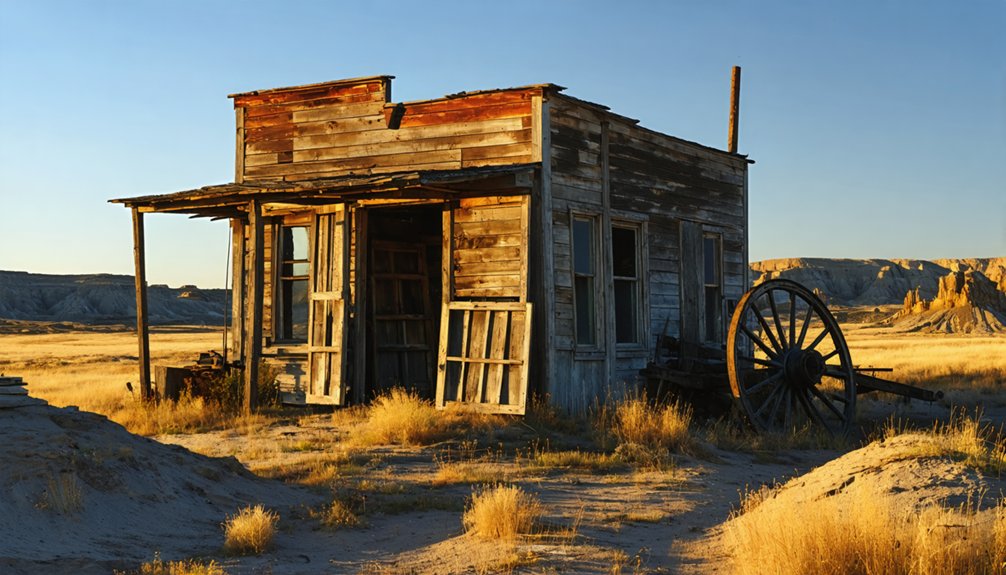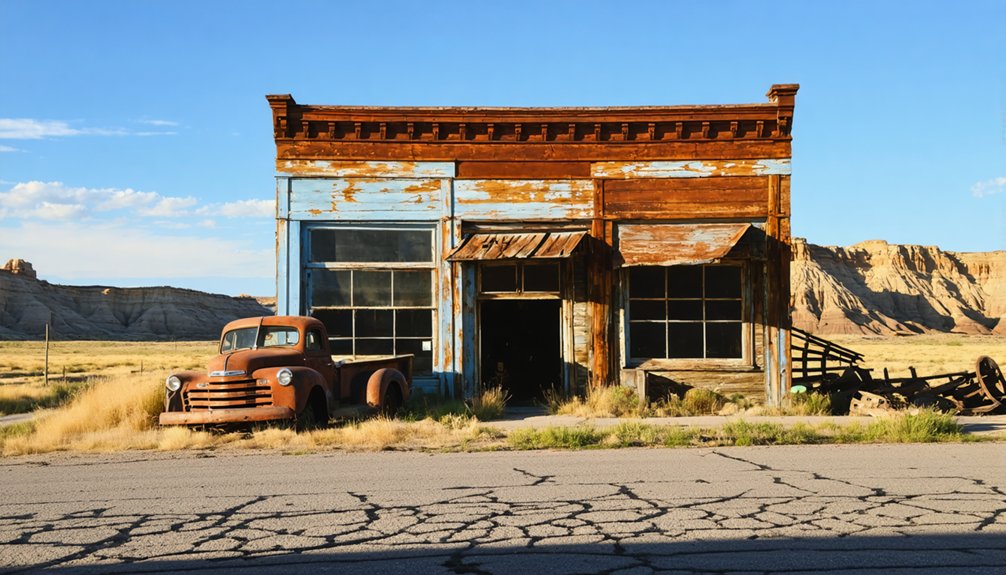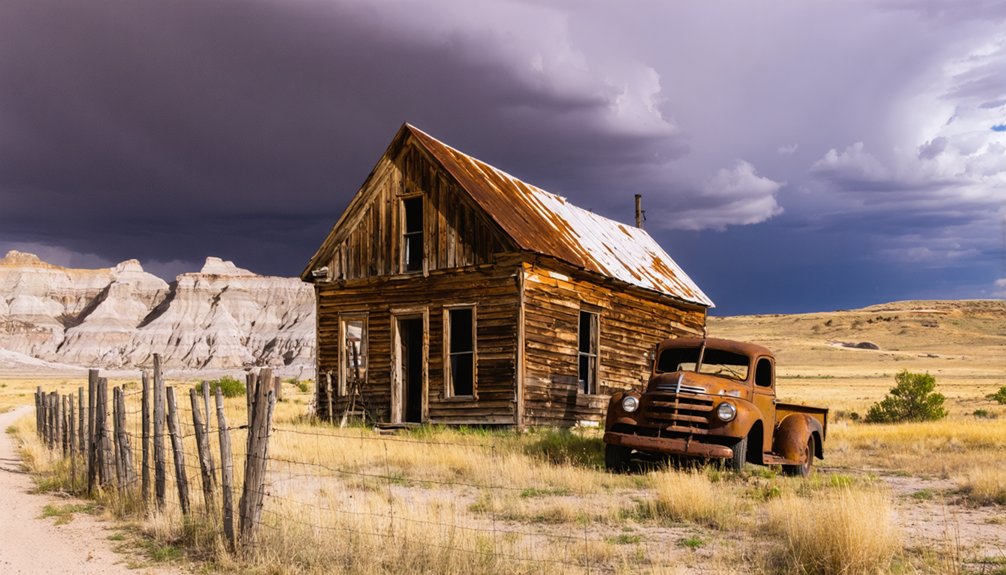You’ll find Conata’s haunting remnants in South Dakota’s Buffalo Gap National Grasslands, where this former railroad boomtown once bustled with nearly 100 residents. Established in 1907 along the Chicago, Burlington and Quincy Railroad, the town supported a sawmill, post office, and reservoir until the 1950s. Today, nature has reclaimed the site, with prairie dog colonies inhabiting the flooded basements and scattered foundations. The town’s rich history echoes across the windswept grasslands, waiting to be discovered.
Key Takeaways
- Conata was established in 1907 as a railroad boomtown near the Black Hills, reaching a peak population of 100 residents.
- The town featured a sawmill, post office, and reservoir, serving as a vital link between Murdo and Rapid City.
- Conata’s decline began with economic challenges, leading to the sawmill’s closure in 1952 and post office closure in 1954.
- Today, only foundations, flooded basements, and a solitary sidewalk remain amid the Buffalo Gap National Grasslands.
- The abandoned town site now hosts North America’s largest prairie dog population and supports diverse wildlife including endangered black-footed ferrets.
The Rise and Fall of a Railroad Town
While many South Dakota towns emerged during the railroad boom of the late 1800s, Conata’s story stands out as a quintessential example of how rail connectivity could make or break a frontier settlement. Like the T-shaped layouts of other railroad towns, Conata followed the standard design patterns of its era.
The region’s growth paralleled the first steam locomotive arriving in Chicago in 1848, setting the stage for westward rail expansion. You’ll find its railroad history intertwined with the Chicago, Burlington and Quincy Railroad system, which transformed this strategic location into a bustling hub of commerce and transportation.
Economic factors initially favored Conata’s growth, as its position near the Black Hills and Buffalo Gap National Grasslands made it ideal for shipping agricultural produce and mining supplies.
But when mid-20th century changes swept through America’s rail system, Conata couldn’t survive. By 1954, the post office closed its doors, and the town’s liveliness faded as automobiles and highways replaced the once-mighty railroads that had given it life.
Life in Peak Conata: a Glimpse Into the Past
During Conata’s peak years in the early to mid-20th century, you’d have found a bustling community of roughly 100 residents nestled in South Dakota’s Buffalo Gap National Grasslands.
Life revolved around the sawmill and railroad, where railroad workers kept the Milwaukee Road‘s crucial transportation link alive. You’d have seen modest wooden homes lining the streets, while the local chapel served as a hub for community gatherings and religious services. Much like nearby Capa Hotel, the town had a small hotel that provided lodging for travelers.
The sawmill and railroad shaped daily life, while the chapel’s spire beckoned neighbors to gather in spiritual communion.
The town’s lifeblood flowed through its working families – farmers tending their lands, sawmill employees processing timber, and shopkeepers providing essential services.
Though living conditions were basic, with occasional flooding challenges, you’d have witnessed a tight-knit community supporting one another through agricultural cycles and industrial work. Today, these flooding issues are still evident through the flooded basements that remain at the site.
The post office, operational until 1954, kept residents connected to the outside world.
Natural Forces and Town Abandonment
As natural forces gradually reclaimed Conata’s landscape, you’d have witnessed the town’s inevitable surrender to the harsh realities of South Dakota’s environment.
Persistent flooding filled basements, while seasonal temperature extremes weakened building foundations. The railroad’s decline left the town increasingly isolated, accelerating its abandonment. Like many Black Hills settlements, the town’s population dwindled as economic opportunities vanished.
Today, you’ll find nature’s ecological resilience on display as prairie dogs scamper through the ruins. Dozens of prairie dogs now call this abandoned town their home. Native grasses have taken root where homes once stood, and the mixed prairie ecosystem demonstrates remarkable natural reclamation of the site.
The flooded basements and scattered farming implements serve as silent witnesses to the power of environmental forces. In the end, Conata’s story mirrors many South Dakota ghost towns, where the combined pressures of harsh climate, flooding, and isolation proved too challenging to overcome.
What Remains: Exploring the Ruins Today
Today’s visitor to Conata encounters a haunting landscape where nature and remnants of human settlement intertwine.
Similar to many sites in disrepair, the area showcases the gradual decay that ghost towns experience over time.
As you explore the ruins, you’ll find flooded basements and scattered foundations marking where buildings once stood. Prairie dogs now claim the territory, darting between rusted farm equipment and automotive debris that dots the empty lots.
Your ruin exploration will reveal buried railroad tracks peeking out from beneath Conata Basin Road, while artifact discovery awaits in every direction.
You can trace the town’s original layout through still-visible lot boundaries, and a lone section of sidewalk serves as a poignant reminder of bustling streets.
Though no buildings remain standing, the site’s accessibility from both sides of the road lets you freely wander this monument to railroad-era ambitions.
Prairie Dogs and Wildlife: Nature’s New Residents
While the human residents of Conata have long since departed, the town’s ruins now serve as a thriving habitat for North America’s largest prairie dog population.
You’ll find these remarkable creatures transforming the abandoned landscape through their intricate prairie dog ecology, creating a complex network of burrows that reshape the terrain.
As you explore this ghost town, you’ll witness the fascinating wildlife interactions between prairie dogs and their fellow inhabitants.
The area’s now home to the world’s largest population of endangered black-footed ferrets, with about 120 of these rare predators patrolling the colony.
Together with bison and ferruginous hawks, they’ve created a dynamic ecosystem where nature’s balance has been restored, turning this once-bustling human settlement into a tribute to wildlife’s resilience.
Dedicated conservation partners perform annual ferret surveys to monitor and protect this remarkable population.
Getting There: Planning Your Visit
The journey to Conata’s wildlife sanctuary begins at the southern terminus of Conata Basin Road, where it meets South Dakota Highway 44.
Begin your trek to this natural wonder where Conata Basin Road intersects Highway 44 in South Dakota’s rugged expanse.
You’ll find the ghost town’s remains about a mile north, scattered on both sides of the road at an elevation of 781 meters within Buffalo Gap National Grasslands.
For successful navigation tips, rely on GPS coordinates (43.7725, -102.2060) and download offline maps, as cell service is spotty.
Road conditions can be challenging – you’re traversing unpaved terrain, so make certain your vehicle’s ready for dirt and gravel paths.
Pack water, wear sturdy boots, and bring essential supplies since you won’t find services here.
Keep an eye out for prairie dog colonies as natural landmarks, and plan your visit during daylight hours.
Remember to respect any private property signs while exploring these historic ruins.
Much like St. Marys in 1886, the site initially grew due to its strategic railroad location.
The site was once bustling with activity when the Chicago, Milwaukee Railroad operated through the area until 1980.
Historical Significance in South Dakota

Nestled within Buffalo Gap National Grasslands, Conata emerged as an essential railroad boomtown in 1907, serving as an important link between Murdo and Rapid City during South Dakota’s rapid expansion westward.
You’ll find in Conata’s story a reflection of the resilience of early settlers who built communities around the Milwaukee Railroad, transforming empty prairie into crucial transportation hubs.
At its peak, this dynamic town supported nearly 100 residents with its sawmill, post office, and reservoir for steam locomotives.
The community’s spirit endured through the devastating Dust Bowl of the 1930s, but like many railroad towns, Conata couldn’t survive the changing times.
When the Milwaukee Railroad shut down in 1980, it marked the end of an era in South Dakota’s railroad expansion, leaving behind poignant reminders of frontier ambition.
Photography and Documentation Tips
Capturing Conata’s haunting beauty requires careful preparation and an eye for detail that’ll transport viewers back to South Dakota’s railroad era.
You’ll want to equip yourself with a high-dynamic-range capable camera, wide-angle and prime lenses, plus a sturdy tripod for those challenging light conditions.
Master your camera settings to document both sweeping townscapes and intimate details.
Composition techniques should focus on establishing shots from elevated vantage points, while incorporating texture-rich elements like weathered wood, rusted metal, and time-worn artifacts.
During golden hours, experiment with natural lighting to enhance architectural features, or try light painting at night for ethereal effects.
Remember to scout locations during daylight first, wear appropriate gear, and always respect the site’s historical integrity as you preserve Conata’s story through your lens.
Legacy of the Lost Community

When you visit Conata today, you’ll find scattered remnants of a once-vibrant railroad community that flourished with nearly 100 residents during its peak years.
The town’s spirit lives on through its visible traces – flooded basements, old foundations, and a solitary sidewalk that stubbornly persists against time and nature.
While the sawmill’s closure in 1952 and the post office’s end in 1954 marked Conata’s fade into ghost town status, the stories of epidemics, floods, and daily life continue to echo across the Buffalo Gap National Grasslands.
Community Stories Live On
Three weathered foundations and scattered debris are all that physically remain of Conata, yet the town’s spirit lives on through fragments of stories passed down by locals.
You’ll find echoes of community memories in the windswept Buffalo Gap National Grasslands, where prairie dogs now claim the terrain that once bustled with railroad activity and small-town commerce.
- The 1954 closure of the post office marked a turning point, as local legends tell of residents gradually dispersing into neighboring communities.
- Floods reshaped not just the land but the destiny of this once-promising settlement.
- You can still trace the town’s footprint among the grasslands, where nature’s reclamation serves as a reflection of the resilient spirit of frontier communities.
Lost Traces Still Remain
Although time has steadily erased much of Conata’s original form, you’ll still find haunting traces of this abandoned railroad town scattered across the Buffalo Gap National Grasslands.
Flooded basements and crumbling foundations peek through the prairie grass, while lost artifacts like farming equipment and automotive remnants rust quietly among the ruins. A solitary sidewalk stretches into nowhere, and the chapel’s remains stand as a silent witness to bygone days.
Prairie dogs now claim this ghost town as their domain, darting between haunting memories of human industry.
The old railroad grade, once Conata’s lifeline, has transformed into a trail where you can walk the same path as those who built, lived in, and ultimately left this monument to South Dakota’s boom-and-bust heritage.
Frequently Asked Questions
Are There Any Reported Ghost Sightings or Paranormal Activities in Conata?
You won’t find documented ghost encounters or paranormal investigations here. While the ruins create an eerie atmosphere with flooded basements and scattered debris, there’s no confirmed supernatural activity in this abandoned locale.
What Happened to the Residents After They Left Conata?
Like scattered seeds in the wind, you won’t find clear records of life after Conata. Residents’ relocation likely led them to nearby farming towns and cities, but their individual paths remain untraceable.
Was Any Gold or Valuable Minerals Ever Discovered Near Conata?
You’ll find that gold deposits were present near Conata during the Black Hills gold rush, though the area’s mineral deposits never matched the riches of nearby Homestake Mine’s legendary discoveries.
Were Any Movies or Documentaries Ever Filmed at Conata?
You won’t find any film history or documentary interest recorded at this location. Despite its ghostly railroad ruins, there’s no evidence that cameras ever rolled for movies or documentaries here.
Did Any Notable Historical Figures Ever Visit or Live in Conata?
You won’t find any record of notable visitors or historical figures in Conata’s brief history. The small railroad town’s limited population and infrastructure didn’t attract anyone of significant historical importance.
References
- https://www.atlasobscura.com/places/conata
- https://www.youtube.com/watch?v=_0WNYsFLSLA
- https://www.sdhspress.com/journal/south-dakota-history-2-2/some-black-hills-ghost-towns-and-their-origins/vol-02-no-2-some-black-hills-ghost-towns-and-their-origins.pdf
- https://kids.kiddle.co/Conata
- https://www.atlasobscura.com/things-to-do/south-dakota/ghost-towns
- https://aberdeenmag.com/2019/01/the-ghost-towns-of-brown-county/
- https://en.wikipedia.org/wiki/List_of_ghost_towns_in_South_Dakota
- https://blackhillsvisitor.com/learn/timeline-of-black-hills-railroads/
- https://www.sdpb.org/rural-life-and-history/The-Rise-and-Fall-of-the-Railways-in-South-Dakota
- https://www.nps.gov/parkhistory/online_books/badl/hrs/chap6.pdf



